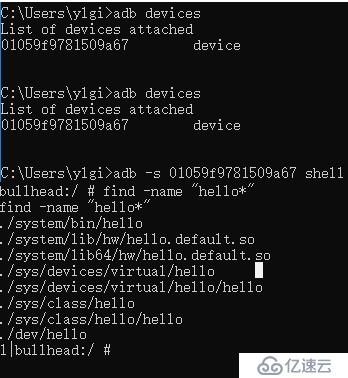您好,登录后才能下订单哦!
小编给大家分享一下Android驱动开发的示例分析,相信大部分人都还不怎么了解,因此分享这篇文章给大家参考一下,希望大家阅读完这篇文章后大有收获,下面让我们一起去了解一下吧!
以下均在Android Linux内核目录下操作, 在drivers目录下创建驱动目录hello
这个目下要创建3个文件,hello.c, Makefile and Kconfig
1.1 hello.ccd driversmkdir hello
vim hello.c
code as follows:
/linux kernel driver: hello.c => /dev/hello /
/create the device file: /sys/class/hello/hello/
please find the code in the below. here skip the code to make the page clean and clear.
1.2 Makefile
Create the Makefile and add:obj-y += hello.o
1.3 Kconfig
Create Kconfig and add:
config HELLO tristate "Eric: First Android Driver" default n help This is the first Android driver.
this file is used when we make menuconfig.
1.4 Modify drivers/Makefile
Add following in the endobj-y += hello.o
1.5 Add the driver into system configuration
Before we build the kernal, we need to config the system.
1.5.1 Modify arch/arm64/Kconfig
Add following in the endsource "drivers/hello/Kconfig"
It seems that this config not work, may be skipped.
1.5.2 Modify drivers/Kconfig
Following the menu:menu "Device Drivers"
Please addsource "drivers/hello/Kconfig"
1.5.3 Modify drivers/Kconfig
make menuconfig
To enble the menu 'Eric: First Android Driver' in the "Device Drivers" item.
And save , then to build the linux kernel code.
以下是需要操作的目录在AOSP目录下
2.1 create the application on externel
在external下创建hello目录
目录下将有两个文件:hello.c and Android.mk
cd external
mkdir hello
vim hello.c
/ AOSP app : ./external/hello.c =>/system/bin/hello/
Android.mk as follows:
LOCAL_PATH := $(call my-dir) include $(CLEAR_VARS) LOCAL_MODULE_TAGS := optional LOCAL_MODULE := hello LOCAL_SRC_FILES := $(call all-subdir-c-files) include $(BUILD_EXECUTABLE)
2.2 build the application
To build the hello applicationmmm external/hello/
Add it into the system.imgmake snod
2.3 Modify the authority of the applicationvim system/core/rootdir/ueventd.rc
Add ‘/dev/hello 0666 root root’ in the end of the file.
Build the AOSP before flash.
2.4 Test/Debug the driver hello
Before flash, we can build the AOSP again, of cource, don't forget replace the linux kernel file 'Image.gz-dtb'.
After flash into the phone, reboot the phone, and then do follows:
C:\Users\ylgi>adb devices List of devices attached 01059f9781509a67 device C:\Users\ylgi>adb -s 01059f9781509a67 shell bullhead:/ $ ls

cd /system/bin ./hello

运行效果如上图,表示Linux驱动已经成功加载并运行。
以下是需要操作的目录在AOSP目录下
3.1 create hello.c file
cd hardware/libhardware/modules mkdir hello vim hello.c
/ to implement the HAL/
3.2 create hello.h file
vim hardware/libhardware/include/hardware/hello.h
/add the implement /
#ifndef ANDROID_HELLO_INTERFACE_H
#define ANDROID_HELLO_INTERFACE_H
#include <hardware/hardware.h>
__BEGIN_DECLS
#define HELLO_HARDWARE_MODULE_ID "hello"//ID
struct hello_module_t {
struct hw_module_t common;
};//hw_module_t的继承者
struct hello_device_t {
struct hw_device_t common; int fd; int (*set_val)(struct hello_device_t* dev, int val); int (*get_val)(struct hello_device_t* dev, int* val);
};//hw_device_t的继承者
__END_DECLS
#endif
..............................
3.3 create Android.mk filevim Android.mk
LOCAL_PATH := $(call my-dir)
include $(CLEAR_VARS)
LOCAL_MODULE := hello.default
LOCAL_MODULE_RELATIVE_PATH := hw
LOCAL_SRC_FILES := hello.c
LOCAL_SHARED_LIBRARIES := liblog
LOCAL_MODULE_TAGS := optional
include $(BUILD_SHARED_LIBRARY)
3.4 build the hello modulemmm hardware/libhardware/modules/hello
then check the so file in the path:ll out/target/product/bullhead/system/lib/hw/hello.default.so
4.1 create com_android_server_HelloService.cpp
cd frameworks/base/services/core/jni
vim com_android_server_HelloService.cpp
其中:
HELLO_HARDWARE_MODULE_ID为hardware/libhardware/include/hardware/hello.h中定义的hello模块名字,
jniRegisterNativeMethods注册HelloService包路径为com.android.server.HelloService
4.2 Modify onload.cppcd frameworks/base/services/core/jni/vim onload.cpp
namespace android {
........
int register_android_server_HelloService(JNIEnv *env);//added by eric.y
};extern "C" jint JNI_OnLoad(JavaVM vm, void / reserved /)
{
..............
register_android_server_HelloService(env);//add by eric
return JNI_VERSION_1_4;
}
4.3 Modify Android.mk
cd frameworks/base/services/core/jni/vim Android.mk
LOCAL_SRC_FILES += \ .................... $(LOCAL_REL_DIR)/com_android_server_HelloService.cpp \ $(LOCAL_REL_DIR)/onload.cpp
4.4 build the jni modulemmm frameworks/base/services/core/jnimmm frameworks/base/services/core/jnimake snod
out/target/product/bullhead/system/lib/libandroid_servers.so
5.1 建立aidl通信接口;
AOSP目录下操作cd frameworks/base/core/java/android/os/vim IHelloService.aidl
package android.os;
interface IHelloService {
void setVal(int val);
int getVal();
}5.2 在system_server中注册hello_service到servicemanager cd frameworks/base/services/java/com/android/server/vim SystemServer.java
try {
Slog.i(TAG, "Service: hello");
ServiceManager.addService("hello", new HelloService());//
} catch (Throwable e) {
Slog.e(TAG, "Failure starting Service: hello", e);
}5.3 实现hello_service
create the service file
cd frameworks/base/services/core/java/com/android/server/vim HelloService.java
/------Eric: hello service-----/
package com.android.server;
import android.content.Context;
import android.os.IHelloService;
public class HelloService extends IHelloService.Stub {
private static final String TAG = "HelloService";
HelloService() {
init_native();
}
public void setVal(int val) {
setVal_native(val);
}
public int getVal() {
return getVal_native();
}
//native implement from HAL layer
private static native boolean init_native();
private static native void setVal_native(int val);
private static native int getVal_native();
};5.4 modify the Android.mk
cd frameworks/base/vim Android.mk
add follow into LOCAL_SRC_FILES +=core/java/android/os/IHelloService.aidl \
5.5 Build the service
mmm frameworks/base
5.6 Add into the SELinux
android5.0以后的系统引入了SELinux,要想让JNI可以成功的访问/dev/hello硬件就必须修改SELinux的策略,否则Android系统再启动是就是出现
add_service ('hello',4e) uid=1000 - PERMISSION DENIED 的错误信息。
AOSP中,SELinux相关的策略配置文件保存在 /external/sepolicy/中,为了完成我们这次实验,需要修改5个 .te 文件.
modify: system/sepolicy/service.te
Add following:type hello_service, system_api_service, system_server_service, service_manager_type;
modify: external\sepolicy\service_contexts
Add following:hello u:object_r:hello_service:s0
为了确保修改后的 .te 文件被成功的编译进system.img 建议执行一次 make update-api ,然后重新执行 make 进行编译make -j4
5.6 Double check the service
To double check if the serivce works:service list | grep hello

6.1 create the NfcPosTest applicatoin with button and edit box
copy android project NfcPosTest into the packages/experimental/
代码中需要调用到:
import android.os.IHelloService;
//请求hello_service
private IHelloService helloService = null;
helloService = IHelloService.Stub.asInterface(
ServiceManager.getService("hello"));
//调用HAL接口
int val = helloService.getVal();
String text = String.valueOf(val);
valueText.setText(text);
6.2 Add the Android.mk
vim packages/experimental/NfcPosTest/Android.mk
LOCAL_PATH:= $(call my-dir)
include $(CLEAR_VARS)
LOCAL_MODULE_TAGS := optional
LOCAL_SRC_FILES := $(call all-subdir-java-files)
LOCAL_PACKAGE_NAME := NfcPosTest
include $(BUILD_PACKAGE)
6.3 build the application
build the demo:mmm packages/experimental/NfcPosTest
succeeded check the apk file in the path:ll out/target/product/bullhead/system/app/NfcPosDemo.apk
6.4 update system.img
make snod
以上是“Android驱动开发的示例分析”这篇文章的所有内容,感谢各位的阅读!相信大家都有了一定的了解,希望分享的内容对大家有所帮助,如果还想学习更多知识,欢迎关注亿速云行业资讯频道!
免责声明:本站发布的内容(图片、视频和文字)以原创、转载和分享为主,文章观点不代表本网站立场,如果涉及侵权请联系站长邮箱:is@yisu.com进行举报,并提供相关证据,一经查实,将立刻删除涉嫌侵权内容。